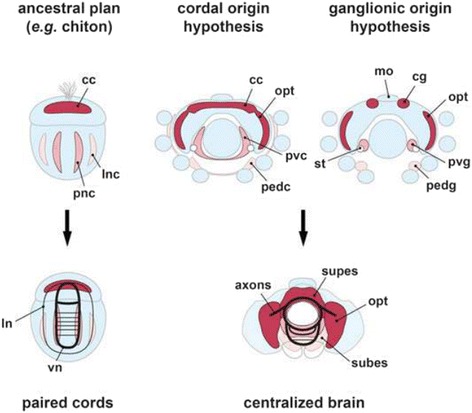Fig. 1.

Traditional and alternative models for early brain development in cephalopods compared with the proposed ancestral cord-like nervous system of chitons. Left Panels, the cordal organization of the chiton nervous system. Middle and Right Panels, the competing hypotheses for a cordal (Middle) or ganglionic (Right) spatial pattern of octopus nervous system development. Upper Panels, cartoons of the chiton trochophore larva and coleoid cephalopod embryo with the apical organ, or mouth (mo), to the top. Lower Panels, cartoon of late embryogenesis when, in chitons (Left), the major commissures and connectives are present and, in cephalopods (Right), the neuronal primordia have formed masses surrounding the esophagus. Upper Right Panel: Traditional section reconstruction studies concluded that brain neurons are initially clustered in spherical structures as ganglia [13, 14]. Upper Middle Panel: An alternative model in which the allocation of brain neurons is to cord-like territories similar to the arrangement described for polyplacophoran nervous systems. There is not yet a study of chiton neurogenesis employing pan-neuronal gene markers; the pattern illustrated on the left is inferred from immunocytochemical study of early and late larval stages [54, 56]. cc, cerebral cord; cg, cerebral ganglion; ln, lateral neurite bundle; lnc, lateral nerve cord; opt, optic lobe; pedc, pedal cord; pedg, pedal ganglion; pnc, pedal nerve cord; pvc, palliovisceral cord; pvg, palliovisceral ganglion; st, statocyst; subes, subesophageal mass; supes, supraesophageal mass; vn, ventral neurite bundle
